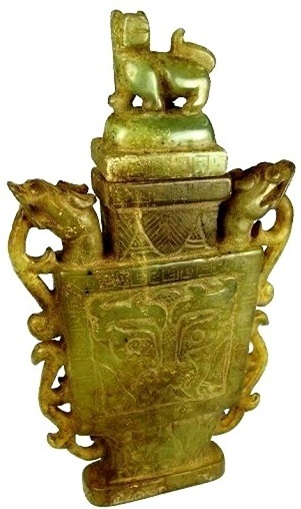 This interesting object recently found its way into our home. It’s a jade vessel dating from China’s Yuan Dynasty. It appeared on the breakfast table one morning at the end of January. To be honest, at first I wasn’t so sure about it, but the more I consider it, the more I’m taking a shine to it.
This interesting object recently found its way into our home. It’s a jade vessel dating from China’s Yuan Dynasty. It appeared on the breakfast table one morning at the end of January. To be honest, at first I wasn’t so sure about it, but the more I consider it, the more I’m taking a shine to it.
We’ve got to clean it up a bit, but its really quite nice when light is shone behind it: the waves and tails of the sea monsters along the edge glow gold along with the ears, paws and tail of the lion or tiger on the lid. It was used to hold a dark substance, perhaps caked ink or makeup or perfume or oil – we’re not sure.
The sea monsters are a fairly standard Yuan theme. The square repetitive border is also a standard in Song/Yuan jades . . . but those triangles look suspiciously like yurts to me – which I’ve never heard of before in a jade.
What I like best about it is that history is written in its very form. The overall shape is nice enough, but the incision work is rather crude indicating a lesser skilled artisan or even an individual owner did that carving. Jade had come into use for everyday objects in the Song Dynasty and became even more commonplace under the Yuan. Some incredibly fine jades exist from this period, but most of those have royal or noble provenance. It is possible that the Mongolian court drew the best artisans to the center and that people rungs down on the social order wishing a jade vessel such as this had to make due with the craftsmen available, or to incise it themselves.
In general, the time of the Mongolian consolidation of power was a time of great social and political upheaval in China. The Han majority saw the Khans as foreign invaders and when possible, the nobles withdrew and refused to participate in courtly life. Heavy taxation of the peasants to help pay for wars of territorial expansion also made them unpopular with many of the common folk as well.
On a positive note, the Yuan period was a time of great flowering of the arts and sciences in China. This was in part due to contact with foreigners from countries under the sway of neighboring Khanates. Astronomy and mathematics flourished with assistance Persian and Arab scholars, advances were made in printing and typography, the hand cannon was developed, cloisonné came east from Byzantium and was eagerly embraced by the Chinese. It was also during this time that Marco Polo and Ibn Battuta traveled to China. Mongolian troops escorted Northern Silk Road caravans as far west as the shores of the Caspian, and China’s power stretched all the way to the borders of Poland and Hungary.
So from the time of Kublai Khan and his descendants, a time far ago and long away, a beautiful jade vessel from the Silk Road has emerged and made its way to our home. (Words by Laura Kelley, Photo of Yuan Jade Vessel by Laura Kelley.)
